Analyzing Interests and Challenges in Vocational Education Training
VerifiedAdded on 2021/05/31
|7
|1713
|89
Report
AI Summary
This report provides an overview of the interests and challenges that Australian employers face in providing vocational education and training (VET). It highlights employer interests such as saving time and costs on training, improving efficiency, and gaining positive employee engagement. The report also addresses challenges like insufficient academic knowledge, high costs, competition, and an aging teacher workforce. It concludes that while VET offers positive outcomes, addressing the negative aspects is crucial for maximizing its benefits. The report emphasizes the importance of VET in developed nations for training employees with appropriate skills and knowledge and suggests that employers should implement contractual agreements to retain employees after training. Desklib offers a range of resources including past papers and solved assignments for students.
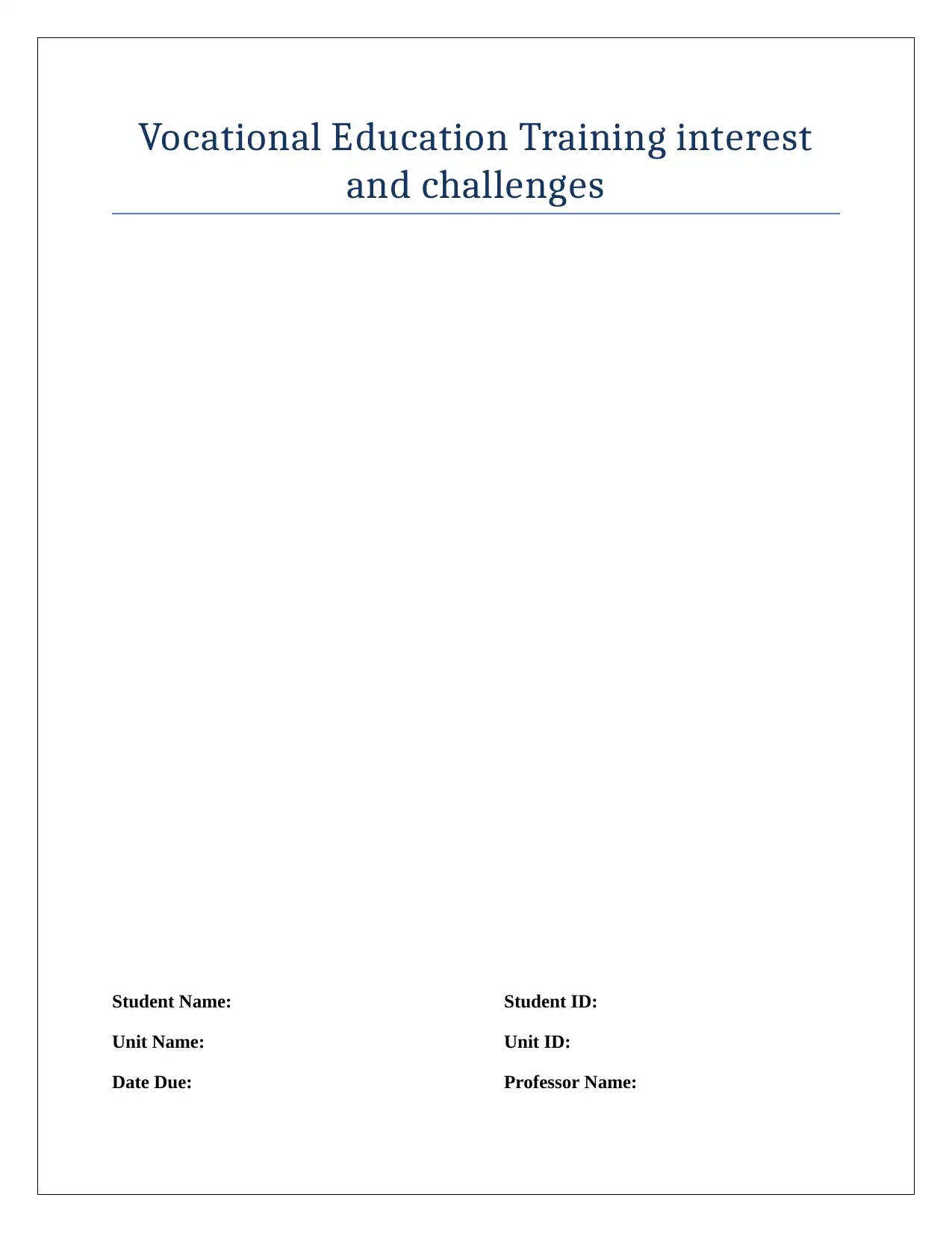
Vocational Education Training interest
and challenges
Student Name: Student ID:
Unit Name: Unit ID:
Date Due: Professor Name:
and challenges
Student Name: Student ID:
Unit Name: Unit ID:
Date Due: Professor Name:
Paraphrase This Document
Need a fresh take? Get an instant paraphrase of this document with our AI Paraphraser
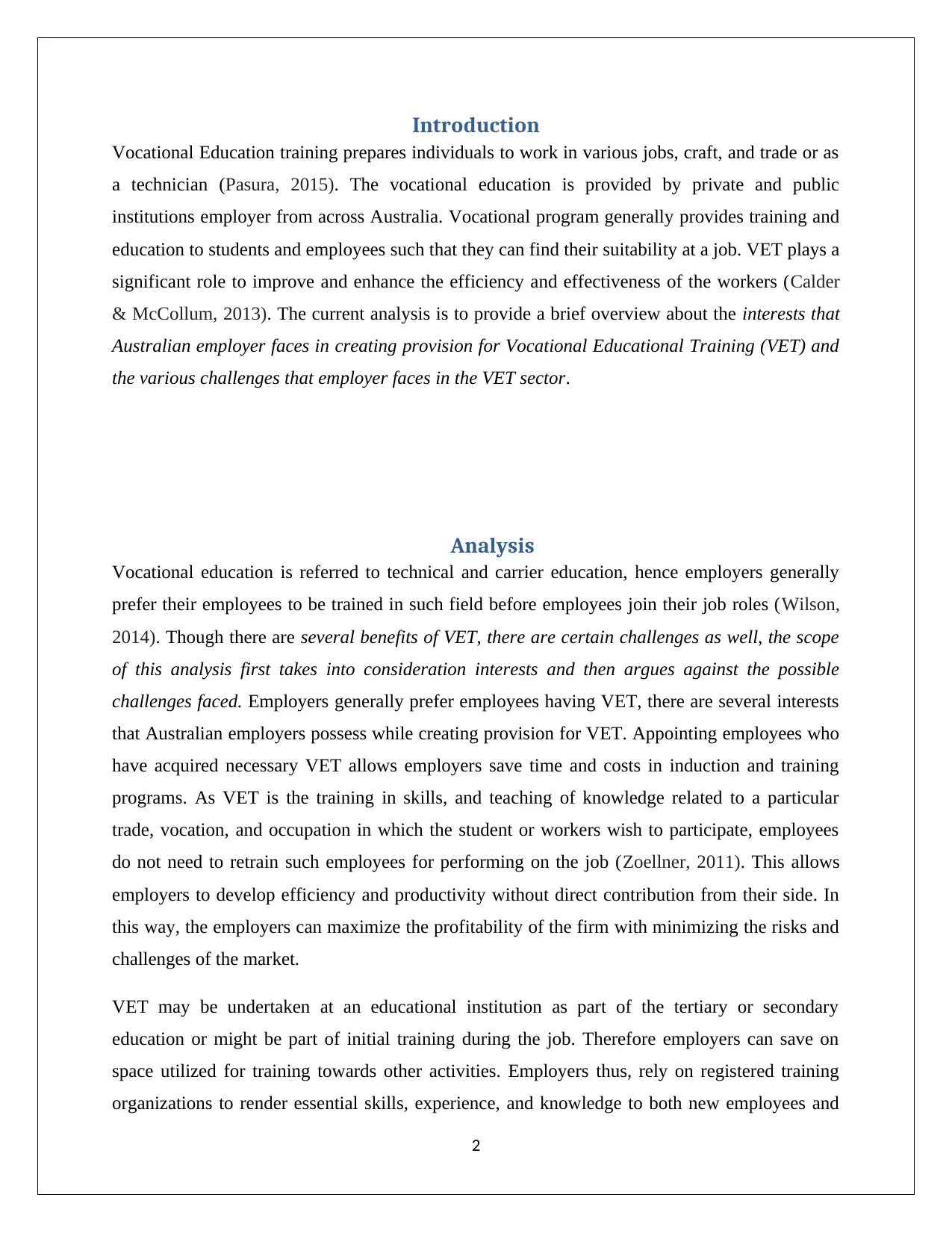
Introduction
Vocational Education training prepares individuals to work in various jobs, craft, and trade or as
a technician (Pasura, 2015). The vocational education is provided by private and public
institutions employer from across Australia. Vocational program generally provides training and
education to students and employees such that they can find their suitability at a job. VET plays a
significant role to improve and enhance the efficiency and effectiveness of the workers (Calder
& McCollum, 2013). The current analysis is to provide a brief overview about the interests that
Australian employer faces in creating provision for Vocational Educational Training (VET) and
the various challenges that employer faces in the VET sector.
Analysis
Vocational education is referred to technical and carrier education, hence employers generally
prefer their employees to be trained in such field before employees join their job roles (Wilson,
2014). Though there are several benefits of VET, there are certain challenges as well, the scope
of this analysis first takes into consideration interests and then argues against the possible
challenges faced. Employers generally prefer employees having VET, there are several interests
that Australian employers possess while creating provision for VET. Appointing employees who
have acquired necessary VET allows employers save time and costs in induction and training
programs. As VET is the training in skills, and teaching of knowledge related to a particular
trade, vocation, and occupation in which the student or workers wish to participate, employees
do not need to retrain such employees for performing on the job (Zoellner, 2011). This allows
employers to develop efficiency and productivity without direct contribution from their side. In
this way, the employers can maximize the profitability of the firm with minimizing the risks and
challenges of the market.
VET may be undertaken at an educational institution as part of the tertiary or secondary
education or might be part of initial training during the job. Therefore employers can save on
space utilized for training towards other activities. Employers thus, rely on registered training
organizations to render essential skills, experience, and knowledge to both new employees and
2
Vocational Education training prepares individuals to work in various jobs, craft, and trade or as
a technician (Pasura, 2015). The vocational education is provided by private and public
institutions employer from across Australia. Vocational program generally provides training and
education to students and employees such that they can find their suitability at a job. VET plays a
significant role to improve and enhance the efficiency and effectiveness of the workers (Calder
& McCollum, 2013). The current analysis is to provide a brief overview about the interests that
Australian employer faces in creating provision for Vocational Educational Training (VET) and
the various challenges that employer faces in the VET sector.
Analysis
Vocational education is referred to technical and carrier education, hence employers generally
prefer their employees to be trained in such field before employees join their job roles (Wilson,
2014). Though there are several benefits of VET, there are certain challenges as well, the scope
of this analysis first takes into consideration interests and then argues against the possible
challenges faced. Employers generally prefer employees having VET, there are several interests
that Australian employers possess while creating provision for VET. Appointing employees who
have acquired necessary VET allows employers save time and costs in induction and training
programs. As VET is the training in skills, and teaching of knowledge related to a particular
trade, vocation, and occupation in which the student or workers wish to participate, employees
do not need to retrain such employees for performing on the job (Zoellner, 2011). This allows
employers to develop efficiency and productivity without direct contribution from their side. In
this way, the employers can maximize the profitability of the firm with minimizing the risks and
challenges of the market.
VET may be undertaken at an educational institution as part of the tertiary or secondary
education or might be part of initial training during the job. Therefore employers can save on
space utilized for training towards other activities. Employers thus, rely on registered training
organizations to render essential skills, experience, and knowledge to both new employees and
2
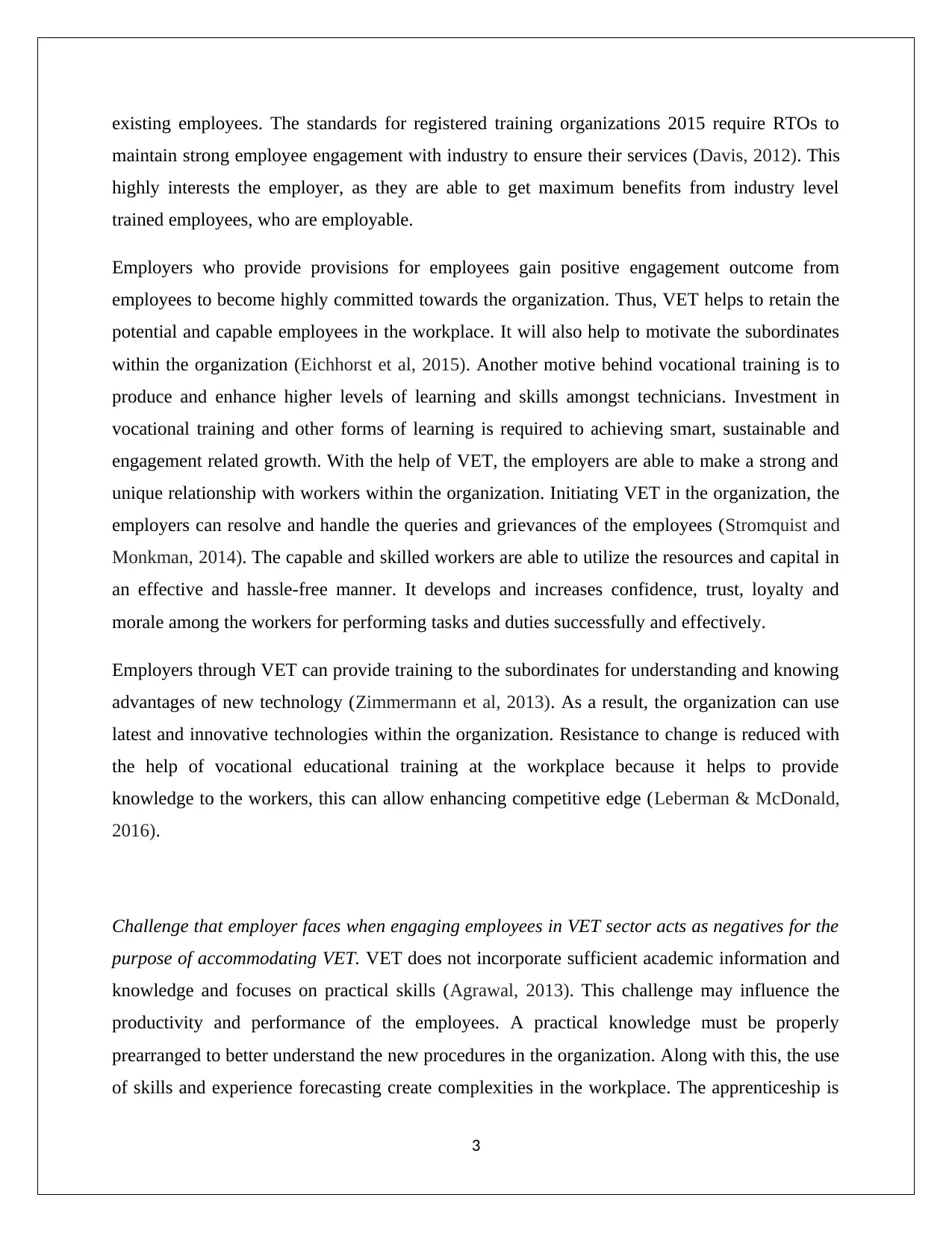
existing employees. The standards for registered training organizations 2015 require RTOs to
maintain strong employee engagement with industry to ensure their services (Davis, 2012). This
highly interests the employer, as they are able to get maximum benefits from industry level
trained employees, who are employable.
Employers who provide provisions for employees gain positive engagement outcome from
employees to become highly committed towards the organization. Thus, VET helps to retain the
potential and capable employees in the workplace. It will also help to motivate the subordinates
within the organization (Eichhorst et al, 2015). Another motive behind vocational training is to
produce and enhance higher levels of learning and skills amongst technicians. Investment in
vocational training and other forms of learning is required to achieving smart, sustainable and
engagement related growth. With the help of VET, the employers are able to make a strong and
unique relationship with workers within the organization. Initiating VET in the organization, the
employers can resolve and handle the queries and grievances of the employees (Stromquist and
Monkman, 2014). The capable and skilled workers are able to utilize the resources and capital in
an effective and hassle-free manner. It develops and increases confidence, trust, loyalty and
morale among the workers for performing tasks and duties successfully and effectively.
Employers through VET can provide training to the subordinates for understanding and knowing
advantages of new technology (Zimmermann et al, 2013). As a result, the organization can use
latest and innovative technologies within the organization. Resistance to change is reduced with
the help of vocational educational training at the workplace because it helps to provide
knowledge to the workers, this can allow enhancing competitive edge (Leberman & McDonald,
2016).
Challenge that employer faces when engaging employees in VET sector acts as negatives for the
purpose of accommodating VET. VET does not incorporate sufficient academic information and
knowledge and focuses on practical skills (Agrawal, 2013). This challenge may influence the
productivity and performance of the employees. A practical knowledge must be properly
prearranged to better understand the new procedures in the organization. Along with this, the use
of skills and experience forecasting create complexities in the workplace. The apprenticeship is
3
maintain strong employee engagement with industry to ensure their services (Davis, 2012). This
highly interests the employer, as they are able to get maximum benefits from industry level
trained employees, who are employable.
Employers who provide provisions for employees gain positive engagement outcome from
employees to become highly committed towards the organization. Thus, VET helps to retain the
potential and capable employees in the workplace. It will also help to motivate the subordinates
within the organization (Eichhorst et al, 2015). Another motive behind vocational training is to
produce and enhance higher levels of learning and skills amongst technicians. Investment in
vocational training and other forms of learning is required to achieving smart, sustainable and
engagement related growth. With the help of VET, the employers are able to make a strong and
unique relationship with workers within the organization. Initiating VET in the organization, the
employers can resolve and handle the queries and grievances of the employees (Stromquist and
Monkman, 2014). The capable and skilled workers are able to utilize the resources and capital in
an effective and hassle-free manner. It develops and increases confidence, trust, loyalty and
morale among the workers for performing tasks and duties successfully and effectively.
Employers through VET can provide training to the subordinates for understanding and knowing
advantages of new technology (Zimmermann et al, 2013). As a result, the organization can use
latest and innovative technologies within the organization. Resistance to change is reduced with
the help of vocational educational training at the workplace because it helps to provide
knowledge to the workers, this can allow enhancing competitive edge (Leberman & McDonald,
2016).
Challenge that employer faces when engaging employees in VET sector acts as negatives for the
purpose of accommodating VET. VET does not incorporate sufficient academic information and
knowledge and focuses on practical skills (Agrawal, 2013). This challenge may influence the
productivity and performance of the employees. A practical knowledge must be properly
prearranged to better understand the new procedures in the organization. Along with this, the use
of skills and experience forecasting create complexities in the workplace. The apprenticeship is
3
⊘ This is a preview!⊘
Do you want full access?
Subscribe today to unlock all pages.

Trusted by 1+ million students worldwide
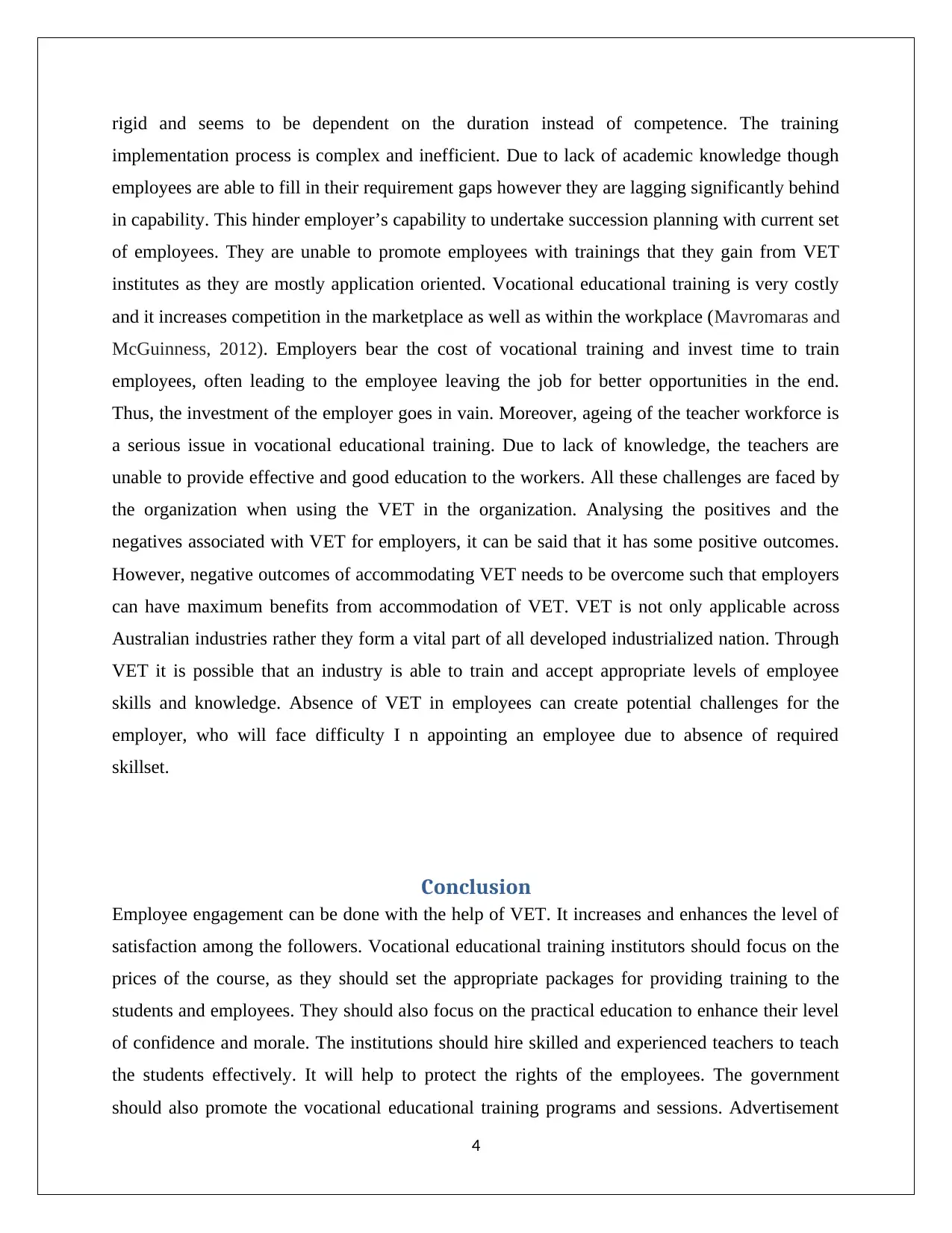
rigid and seems to be dependent on the duration instead of competence. The training
implementation process is complex and inefficient. Due to lack of academic knowledge though
employees are able to fill in their requirement gaps however they are lagging significantly behind
in capability. This hinder employer’s capability to undertake succession planning with current set
of employees. They are unable to promote employees with trainings that they gain from VET
institutes as they are mostly application oriented. Vocational educational training is very costly
and it increases competition in the marketplace as well as within the workplace (Mavromaras and
McGuinness, 2012). Employers bear the cost of vocational training and invest time to train
employees, often leading to the employee leaving the job for better opportunities in the end.
Thus, the investment of the employer goes in vain. Moreover, ageing of the teacher workforce is
a serious issue in vocational educational training. Due to lack of knowledge, the teachers are
unable to provide effective and good education to the workers. All these challenges are faced by
the organization when using the VET in the organization. Analysing the positives and the
negatives associated with VET for employers, it can be said that it has some positive outcomes.
However, negative outcomes of accommodating VET needs to be overcome such that employers
can have maximum benefits from accommodation of VET. VET is not only applicable across
Australian industries rather they form a vital part of all developed industrialized nation. Through
VET it is possible that an industry is able to train and accept appropriate levels of employee
skills and knowledge. Absence of VET in employees can create potential challenges for the
employer, who will face difficulty I n appointing an employee due to absence of required
skillset.
Conclusion
Employee engagement can be done with the help of VET. It increases and enhances the level of
satisfaction among the followers. Vocational educational training institutors should focus on the
prices of the course, as they should set the appropriate packages for providing training to the
students and employees. They should also focus on the practical education to enhance their level
of confidence and morale. The institutions should hire skilled and experienced teachers to teach
the students effectively. It will help to protect the rights of the employees. The government
should also promote the vocational educational training programs and sessions. Advertisement
4
implementation process is complex and inefficient. Due to lack of academic knowledge though
employees are able to fill in their requirement gaps however they are lagging significantly behind
in capability. This hinder employer’s capability to undertake succession planning with current set
of employees. They are unable to promote employees with trainings that they gain from VET
institutes as they are mostly application oriented. Vocational educational training is very costly
and it increases competition in the marketplace as well as within the workplace (Mavromaras and
McGuinness, 2012). Employers bear the cost of vocational training and invest time to train
employees, often leading to the employee leaving the job for better opportunities in the end.
Thus, the investment of the employer goes in vain. Moreover, ageing of the teacher workforce is
a serious issue in vocational educational training. Due to lack of knowledge, the teachers are
unable to provide effective and good education to the workers. All these challenges are faced by
the organization when using the VET in the organization. Analysing the positives and the
negatives associated with VET for employers, it can be said that it has some positive outcomes.
However, negative outcomes of accommodating VET needs to be overcome such that employers
can have maximum benefits from accommodation of VET. VET is not only applicable across
Australian industries rather they form a vital part of all developed industrialized nation. Through
VET it is possible that an industry is able to train and accept appropriate levels of employee
skills and knowledge. Absence of VET in employees can create potential challenges for the
employer, who will face difficulty I n appointing an employee due to absence of required
skillset.
Conclusion
Employee engagement can be done with the help of VET. It increases and enhances the level of
satisfaction among the followers. Vocational educational training institutors should focus on the
prices of the course, as they should set the appropriate packages for providing training to the
students and employees. They should also focus on the practical education to enhance their level
of confidence and morale. The institutions should hire skilled and experienced teachers to teach
the students effectively. It will help to protect the rights of the employees. The government
should also promote the vocational educational training programs and sessions. Advertisement
4
Paraphrase This Document
Need a fresh take? Get an instant paraphrase of this document with our AI Paraphraser

strategies shall be used to promote and encourager this education. Employers need to
accommodate contractual agreements that allow them to retain employee’s posts such training
ends. This will allow employers to benefit from the investment they make towards VET for its
employees.
5
accommodate contractual agreements that allow them to retain employee’s posts such training
ends. This will allow employers to benefit from the investment they make towards VET for its
employees.
5
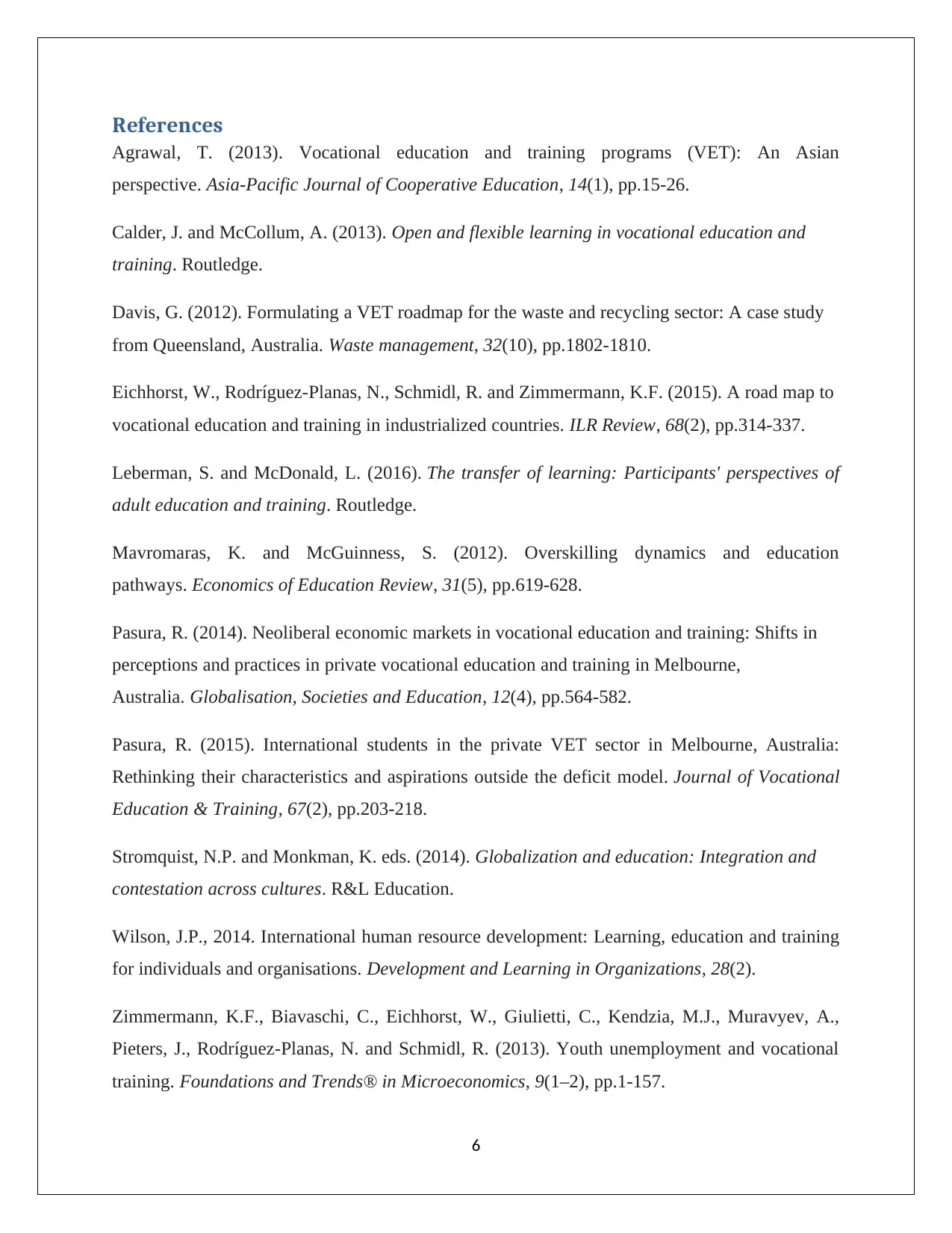
References
Agrawal, T. (2013). Vocational education and training programs (VET): An Asian
perspective. Asia-Pacific Journal of Cooperative Education, 14(1), pp.15-26.
Calder, J. and McCollum, A. (2013). Open and flexible learning in vocational education and
training. Routledge.
Davis, G. (2012). Formulating a VET roadmap for the waste and recycling sector: A case study
from Queensland, Australia. Waste management, 32(10), pp.1802-1810.
Eichhorst, W., Rodríguez-Planas, N., Schmidl, R. and Zimmermann, K.F. (2015). A road map to
vocational education and training in industrialized countries. ILR Review, 68(2), pp.314-337.
Leberman, S. and McDonald, L. (2016). The transfer of learning: Participants' perspectives of
adult education and training. Routledge.
Mavromaras, K. and McGuinness, S. (2012). Overskilling dynamics and education
pathways. Economics of Education Review, 31(5), pp.619-628.
Pasura, R. (2014). Neoliberal economic markets in vocational education and training: Shifts in
perceptions and practices in private vocational education and training in Melbourne,
Australia. Globalisation, Societies and Education, 12(4), pp.564-582.
Pasura, R. (2015). International students in the private VET sector in Melbourne, Australia:
Rethinking their characteristics and aspirations outside the deficit model. Journal of Vocational
Education & Training, 67(2), pp.203-218.
Stromquist, N.P. and Monkman, K. eds. (2014). Globalization and education: Integration and
contestation across cultures. R&L Education.
Wilson, J.P., 2014. International human resource development: Learning, education and training
for individuals and organisations. Development and Learning in Organizations, 28(2).
Zimmermann, K.F., Biavaschi, C., Eichhorst, W., Giulietti, C., Kendzia, M.J., Muravyev, A.,
Pieters, J., Rodríguez-Planas, N. and Schmidl, R. (2013). Youth unemployment and vocational
training. Foundations and Trends® in Microeconomics, 9(1–2), pp.1-157.
6
Agrawal, T. (2013). Vocational education and training programs (VET): An Asian
perspective. Asia-Pacific Journal of Cooperative Education, 14(1), pp.15-26.
Calder, J. and McCollum, A. (2013). Open and flexible learning in vocational education and
training. Routledge.
Davis, G. (2012). Formulating a VET roadmap for the waste and recycling sector: A case study
from Queensland, Australia. Waste management, 32(10), pp.1802-1810.
Eichhorst, W., Rodríguez-Planas, N., Schmidl, R. and Zimmermann, K.F. (2015). A road map to
vocational education and training in industrialized countries. ILR Review, 68(2), pp.314-337.
Leberman, S. and McDonald, L. (2016). The transfer of learning: Participants' perspectives of
adult education and training. Routledge.
Mavromaras, K. and McGuinness, S. (2012). Overskilling dynamics and education
pathways. Economics of Education Review, 31(5), pp.619-628.
Pasura, R. (2014). Neoliberal economic markets in vocational education and training: Shifts in
perceptions and practices in private vocational education and training in Melbourne,
Australia. Globalisation, Societies and Education, 12(4), pp.564-582.
Pasura, R. (2015). International students in the private VET sector in Melbourne, Australia:
Rethinking their characteristics and aspirations outside the deficit model. Journal of Vocational
Education & Training, 67(2), pp.203-218.
Stromquist, N.P. and Monkman, K. eds. (2014). Globalization and education: Integration and
contestation across cultures. R&L Education.
Wilson, J.P., 2014. International human resource development: Learning, education and training
for individuals and organisations. Development and Learning in Organizations, 28(2).
Zimmermann, K.F., Biavaschi, C., Eichhorst, W., Giulietti, C., Kendzia, M.J., Muravyev, A.,
Pieters, J., Rodríguez-Planas, N. and Schmidl, R. (2013). Youth unemployment and vocational
training. Foundations and Trends® in Microeconomics, 9(1–2), pp.1-157.
6
⊘ This is a preview!⊘
Do you want full access?
Subscribe today to unlock all pages.

Trusted by 1+ million students worldwide

Zoellner, D. (2011). Change and VET–thinking the unthinkable. In Avetra Annual Conference,
Melbourne.
7
Melbourne.
7
1 out of 7
Related Documents
Your All-in-One AI-Powered Toolkit for Academic Success.
+13062052269
info@desklib.com
Available 24*7 on WhatsApp / Email
![[object Object]](/_next/static/media/star-bottom.7253800d.svg)
Unlock your academic potential
Copyright © 2020–2025 A2Z Services. All Rights Reserved. Developed and managed by ZUCOL.




